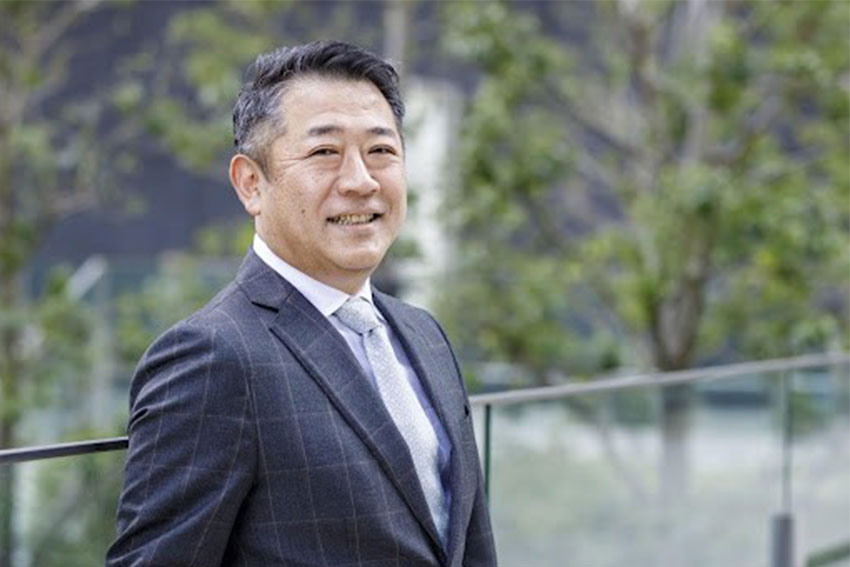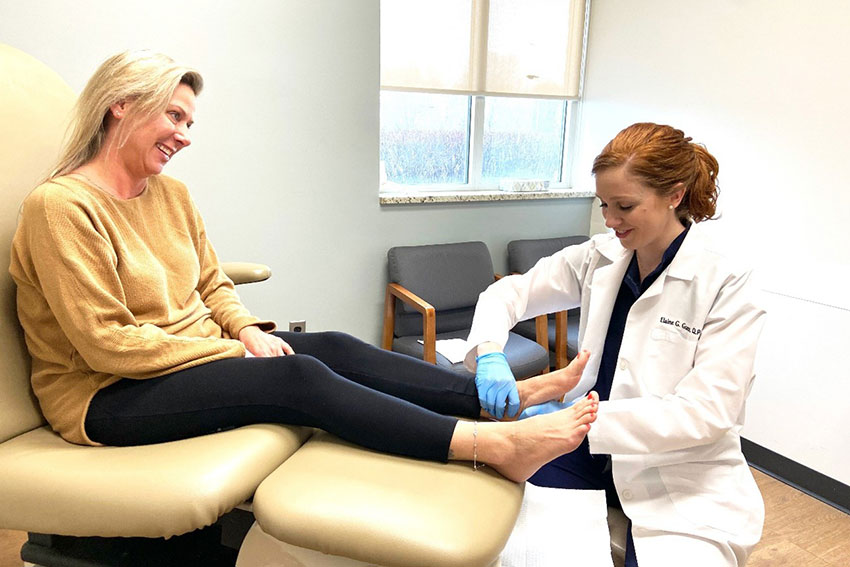Building towards a future where children will live CUC ceaselessly pursues a vision of better healthcare, and is committed to creating a society where people feel secure and reassured.

Japan is becoming a super-aging society. This is creating a series of challenges, not only in terms of labor but also in terms of a shrinking domestic market and demand. It’s also creating, for the medical field, a series of deep social issues. How is this demographic evolution affecting CUC?
Our main line of business is the provision of health care targeting aged citizens. One thing that is quite certain to happen is that Japan’s society is aging quickly, and that will be an ongoing situation for the coming 40 years (*1). As you mentioned, the size of the market will shrink. However, there will be a rise in the elderly population that needs healthcare services, which will create a bigger market for our business. Currently, the size of the medical market is JPY 40 trillion, and it will reach JPY 70 trillion. That is a JPY 30 trillion increase, which shows that it is a very big market.
(*1) Cabinet Office, Government of Japan. (2024). Reiwa 6 nenban kōreishakai hakusho [2024 White Paper on Aging Society]. https://www8.cao.go.jp/kourei/whitepaper/w-2024/zenbun/pdf/1s1s_01.pdf
The labor shortage is very relevant to the medical field. We saw during the COVID-19 pandemic many overtime working hours for nurses, doctors, and other people in healthcare because of the shortage. As a result, many ended up having burnout. This compounds the problem because burnout leads to people quitting, which leads to more shortages. How can this vicious circle be stopped, and what is the role of companies like CUC in addressing this?
There was a situation where patients concentrated in the emergency departments of hospitals providing acute care, leading to burnout syndrome among healthcare staff such as doctors and nurses. On the other hand, there were town clinics where the number of patients did not increase as much. Japan has a large number of hospitals and hospital beds, but there are challenges in the distribution and placement of doctors, such as centralization and uneven distribution. It may be a controversial opinion, but in my view, if more doctors move from hospitals to the field of in-home healthcare, more doctors will be able to provide effective care to patients at home.
To explain more specifically, there are not many extremely large hospitals with more than 500 beds in Japan, but there are a very large number of hospitals with less than 300 beds. These medium-sized hospitals employ many healthcare staff, doctors, and nurses. Therefore, by integrating these hospitals into major hub hospitals, the entire medical industry can increase educational opportunities for staff and provide an environment where they can more easily take vacations. For example, in areas outside cities like Sapporo and Asahikawa in Hokkaido, there are cases where there is only one neurosurgeon in a region. When a patient requires surgery, a situation arises where there are no doctors available to treat other patients simultaneously. This is an incredibly stressful situation for doctors.
Your answer seems to be based on common sense. Why is it sensitive to talk about? Why doesn’t everyone agree with this common-sense solution?
Currently, seventy percent of the hospitals in Japan are private businesses, which means that the remaining 30 percent is public (*2). The managers or owners of those private hospitals are more focused on keeping the business going, and their voices have the power to influence.
(*2) Ministry of Health, Labour and Welfare, Japan. (2021). Iryō shisetsu (dōtai) chōsa・byōin hōkoku no gaikyō [Survey of Healthcare Facilities (Dynamic) and Overview of Hospital Reports] https://www.mhlw.go.jp/toukei/saikin/hw/iryosd/21/dl/11gaikyou03.pdf
Many of the owners of those private hospitals are senior citizens. Many times, because those hospitals are located in regional areas, there is not a clear successor to take over the business. Could you explain how your company is providing a solution to this challenge of succession within the medical facility field?
Our philosophy is set to support our customers to grow and gain a higher share of the market. Therefore, consolidation is a very important idea for us. If you combine four hospitals with 100 beds each into a large hospital with 400 beds, this will make things more efficient. We already have some experience achieving such integrations successfully. ONe of the medical institutions we support is acquiring other smaller hospitals, and they will build a large new hospital.
I also believe that CUC will provide highly effective quality service for these hospital managers and owners by providing finance and capability building support. Today’s hospitals are facing many challenges. For example, there is a lack of professional management and difficulty in post-merger operations. However, it is difficult to gather information about hospitals that are potential acquisition targets.
Your hospice business specializes in patients with terminal cancer and patients with severe disease. If you look at Japan and other countries, an aging society multiplies the amount of death that you see daily. This pushes the need for end-of-life care facilities, and many economies around the world realize that this is something they do not have enough of. In Japan, it’s estimated that around half a million people won’t have access to end-of-life care facilities within the next fifteen or twenty years (*3). To address this, your company has been aggressively opening hospice care facilities. For example, last year, you opened four of them, many around Kyoto and regional areas. How do you ensure that the level of service that you can offer to your patients remains high while you’re expanding so aggressively?
We intentionally slowed down our expansion speed two or three years ago to maintain the quality of our service. We made significant investments in our human resources department, particularly in training, and established a safety management division to monitor the quality of care. These two initiatives enable us to continue growing while maintaining service quality.
(*3) Central Social Insurance Medical Council. (2011). Basic data on medical care in Japan: https://www.mhlw.go.jp/stf/shingi/2r9852000001hsqc-att/2r9852000001hswu.pdf

We have created a highly effective educational system which enables us to send staff to work at other facilities. For example, we typically have two managers working under one senior manager. After these two managers have gained sufficient experience and knowledge, they are ready to move to other facilities. We also have a library of rich short video training clips. Each video focuses on a specific area, such as how to bathe a patient with ALS. It is not realistic to expect all staff to memorize how to provide care for every patient with every condition. Therefore, if a staff member feels a little unsure about what kind of care or services they can provide on a regular in-home care visit, they can watch these videos on their way and recap. Also, we have created career and skill ladders for our nursing staff, and we regularly assess how many staff we have at different skill levels. This allows us to quickly determine how many more patients we can accept.
You founded the company in 2014, and it has been quite a success story. In just ten years, you’ve been able to grow into an enterprise with over 3,000 employees, with more than JPY 30 billion in revenue, operating in three key segments. If you look back to 2014, what do you consider to be some of the main milestones of the company, and what do you think have been the key factors for this incredible success?
Several factors led me to start this company. Firstly, I was clearly aware of the rapid increase of social welfare spending, and I also thought that it would be very meaningful for elderly citizens or patients to be able to stay at home and get necessary care. Looking back at the early 2010s, there was a demand for in-home care, so we started to provide support for an in-home clinic which was our first client. Back then, I used to drive a car and visit patients’ houses with doctors and nurses for consultations. In the end, the size of this client’s in-home care service expanded to eight times the original.
We worked to achieve sustainable management by improving the inefficiencies of in-home care clinic operations and establishing ways to reduce the burden on staff. In the process, we had opportunities to address management challenges faced by hospitals and other healthcare facilities. In 2017, we put forward the mission of this group, which is “Creating Hope through Healthcare.” Prior to that, our mission was to establish a standard for elderly care in Japan. The reason we changed our mission is that some of the managers who I discussed intensively said that it was not only about elderly care. We needed to think more broadly, especially since Japan’s population will shrink to about half the current level by 2100
In 2018, I started to think of looking at the situation in other Asian countries. I visited Vietnam and Indonesia, and decided to start our service in these countries. I picked these two countries because they have large populations—90 million in Vietnam and 270 million in Indonesia. In these countries, the average age of the population is still low at around 30 years old. We made sure to investigate the varying regulations and rules in each country.
As part of our ongoing efforts, we are hosting healthcare professionals from Vietnam and Indonesia in Japan. They are gaining valuable experience and expertise in our hospitals, which they will then take back to their home countries to educate their peers.
CUC has strong expertise in dealing with a country with a declining population and a super-aging society, so why did you decide to expand into countries with young populations?
One of our key criteria for expansion was valuing countries with high potential for human resource development. Southeast Asia, particularly Indonesia and Vietnam, are rapidly growing markets, and we believed that contributions from Japanese companies could drive further development and create a significant social impact. From a social contribution perspective, business development in these countries was incredibly attractive.
For example, Vietnam has many private hospitals, but these mainly cater to the wealthy. Our goal was to provide hope to low- and middle-income households who have difficulty accessing proper treatment and quality medical services. In fact, we currently have 1,500 patients visiting our institutions per day. We are not exporting a business model; we are exporting our philosophy and hope. In Vietnam, our vision was to provide high quality and affordable medical care to low- and middle-income households. In Indonesia, we are focusing on dialysis as the number of patients with lifestyle-related diseases is increasing and diabetes is the third leading cause of death. (*4)
(*4) Institute for Health Metrics and Evaluation (IHME) https://www.healthdata.org/indonesia
In 2023, you opened CUC America, which is your foray into the US market. That’s obviously a radically different country with a very peculiar healthcare system. Can you explain your strategy for the US market and why you decided that 2023 was the time to enter North America?
The advantage of expanding into the US market is that we are able to operate in a market with established rules. In emerging markets, rules can change as the market grows, which has been a challenge for us in recent years. The US is the largest market for the healthcare industry. Its technology continues to advance, and it is also expected to maintain rapid growth. While the percentage of elderly people may not increase dramatically in the market, the absolute number of elderly individuals will rise.
Looking at your international expansion over the next five years, which countries do you think will have the highest growth potential?
I think the US will have the biggest potential.
What are the reasons that CUC entered the podiatry field?
We invested in podiatry because elderly and obese people have a lot of problems with their feet. If a patient has some problem with their heart or blood, the symptoms will often appear in their feet, so we decided to jump into the podiatry market, which is a very niche market in the US. I believe that the market will have steady growth, so we can introduce a lot of patients to other specialties. That’s why we see it as a good market entry point.

Are you looking to branch out to other fields after podiatry?
Yes. We have already started in the vein business, and we are considering other intervention options.
You acquired Albaron Podiatry Holdings in January, and this was only one of the many acquisitions that you’ve made over the past year or two. Is there an overriding rationale behind these acquisitions, and looking at the future, are there new acquisitions you are considering?
In Japan, we are not able to acquire a hospital, but in the US, we can directly own and manage a healthcare clinic. To further develop the business at a faster rate, we are planning some other acquisitions after first agreeing on the philosophy with the existing management. That is how we decided to buy Albaron, which has about 30 clinics.
Fiscal year 2024 was a record-breaking year for your financial results. You achieved your highest revenue and profitability. This growth has extended within fiscal year 2025, yet your stock price year to date has gone down approximately 30%. It traded around JPY 3,000 at the beginning of the year, and it is currently trading at around JPY 1,600. Why is there a disconnect between such positive financial results and a declining stock price?
I think one possible factor is simply that there is not much liquidity in the market. In other words, the number of shares in the market is not very high. M3 owns 60%, I own around 6%, and TBJ owns some. Also, some investors hold our shares based on the premise of long-term ownership, and the actual number of shares in circulation is limited. Our expansion into the US may have surprised the market, and I believe some investors are wondering why we are not focusing solely on Japan.
You mentioned M3, which holds a majority stake in the CUC group. M3 is a fascinating enterprise. Their business model consists of being a platform that connects different businesses, not just in Japan but across the world, to solve the challenges of an aging population. Could you tell us about the synergies you can create with the M3 group and with this unique corporate structure?
M3 was a very large company with a very strong financial position and abundant cash flow. In addition, M3 was the number one company in matching medical institutions with doctors and nurses. We initially named the company "M3 Doctor Support" because we wanted to free doctors from tasks that could be done by others. We were able to learn a lot from the labor market in the medical industry, including the recruitment of doctors, so there was a synergistic effect between the two companies. Most CEOs of startup companies are busy raising funds rather than focusing on business operations. However, in our case, M3 invested a considerable amount of money, so that I was able to concentrate on my main business.
As you reflect upon the company since you started it in 2014, what is something you are the proudest of, and what is something you wish you would have done differently?
The first thing that comes to my mind is our people. I’m really proud of being able to work with like-minded people. We have hired many employees, and some have also joined through acquisitions, but the mission has resonated with all of them, so I think this is something I can be really proud of.
In that case, what’s next? What would you like to achieve next?
I always feel that Japanese companies are not seen as strong in terms of their capability in the global market. I really want to do something about this as a business owner and manager.
We can lead this affluent, comfortable life in Japan because many Japanese entrepreneurs and business owners expanded to the global market and worked hard since the 1950s —companies like Sony and Toyota. Because of the hard work of our predecessors, Japan has enjoyed a vibrant economy and a rich lifestyle. However, over the past several decades, Japanese entrepreneurship and ambition to tackle the global market have declined significantly, so people talk about the lost decades. On the other hand, there is hope if you look at the younger generation of people. For example, many of the football players in Japan’s national team have experience in Europe. But in business, we still need strong leaders in the market, so I want to be one of them and motivate other younger entrepreneurs to tackle the global market. That is the reason why I need to be successful in the US market.
For more information, please visit their website at: https://www.cuc-jpn.com/
0 COMMENTS